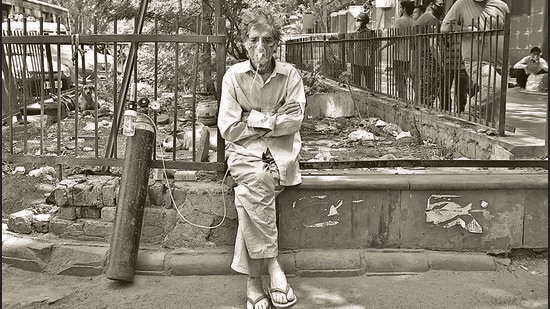Oxygen for India: Building a more resilient health system
The coronavirus pandemic has given us the opportunity to build back better. We can, and should, develop a medical oxygen infrastructure that can keep pace with our ongoing needs, the pandemic, and any future threat
In 2020–21, air became more valuable than gold. Shortages of medical oxygen for Covid-19 patients hit hospitals around the world — Brazil, Peru, Nigeria, Jordan, Italy, and the United States.

But nowhere was the problem more acute than in India, which suffered a spike in cases due to both the rapid spread of the coronavirus in crowded cities and the heightened transmissibility of the Delta variant of the virus. Many Indians died in their homes, unable to secure admission to a hospital, while the hospitals themselves were running out of oxygen.
Medical oxygen is among the most essential and best understood of medical interventions. The earliest use of medical oxygen dates back to 1798, when Thomas Beddoes, considered the father of respiratory therapy, used oxygen and nitrous oxide to treat asthma, congestive heart failure, and other ailments. The first oxygen cylinders, which could be used in general anaesthesia, were developed in 1868. Oxygen’s role in acute care was established by, among others, George Holtzapple, who used it to manage a young pneumonia patient in 1885.
Also Read | HT Explains | The pandemic’s missing AI response and why India should care
The need for oxygen goes well beyond Covid-19, and shortages are a constant problem in India. Pregnant women and children with pneumonia can die without supplemental oxygen. Improving the quality of the oxygen programme at health facilities in Papua New Guinea reduced overall pediatric deaths by 40% and deaths due to pneumonia by 50%. Hypoxemia, lack of oxygen in the bloodstream, can cause complications in a range of conditions, including severe malaria, cardiovascular disease, and traumas that cause blood loss.
Supplemental oxygen helps buy the body time while doctors treat the source of the problem. Doctors also administer oxygen when patients are put under anaesthesia in surgery.
As the second wave of the coronavirus pandemic in India has highlighted, shortages of medical oxygen are not uncommon in urban India, and it is not available at all in remote areas.
The pre-Covid-19 system relied almost entirely on liquid medical oxygen (LMO), which is generated largely for industrial use. Only 15% of liquid oxygen is directed to medical uses.
Eighty per cent of India’s LMO is generated in just eight states and then transported to other states. But liquid oxygen cannot be moved quickly, and transportation infrastructure problems create shortages outside of tier-1 and tier-2 cities.
Oxygen resources — pressure swing adsorption (PSA) plants, oxygen concentrators, and cylinders — have recently entered the country with both significant investment from the national government and support from private philanthropy. PSA plants use an adsorbent like zeolite to separate nitrogen from air under pressure. With funds from PM CARES and contributions from donors, the Government of India has committed to providing one PSA plant and one LMO storage tank for every district headquarters.
All told, an estimated 1,500 PSA plants, 200,000 oxygen concentrators, and 100,000 cylinders are now available not only to tackle any future waves of Covid-19, but also help save lives at risk from several other health conditions.
The opportunity exists to leverage all those PSA plants, concentrators, and cylinders to plug gaps in the existing system. But if such a grid is not assembled carefully, the new oxygen assets could displace or interrupt existing LMO systems and put small fillers and transporters out of business. PSA plants and concentrators need regular maintenance — something most Indian health care facilities cannot provide. We could face a situation where the current oxygen ecosystem is disrupted, with no stable system to replace it.
An ideal oxygen grid for the country would work much like an electricity grid, with central generation (LMO), transmission (tankers and cylinders), storage (liquid and gaseous), and decentralised production (PSA generators and oxygen concentrators).
No electricity grid would rely on just decentralised solar or micro-hydro plants, without centralised transmission and distribution; similarly, a reliable national oxygen grid should have multiple generation and storage components.
Other issues are specific to an oxygen grid. LMO is cheap to produce but expensive to transport over long distances into remote areas. PSA plants can be helpful in places that are poorly served by LMO suppliers but require significant inputs of electricity and are not economically viable as standalone operations. Oxygen concentrators also consume large amounts of electricity.
Both PSA plants and concentrators have compressors and moving parts and are, therefore, susceptible to breakdown under harsh conditions; backup from other generation or storage options is required. We know of remote health centres that requested concentrators but are now returning them because they are simply unusable. Oxygen does have one advantage over electricity: It is easier to store.
A sustainable oxygen grid — one that supplies medical oxygen when and where it is required — needs both centralised and decentralised production, plus reliable transmission, and storage. Such a system would ensure that rural areas are served and that oxygen can be diverted to hotspots.
The coronavirus pandemic has given us the opportunity to build back better. We can, and should, develop a medical oxygen infrastructure that can keep pace with our ongoing needs, the pandemic, and any future threat.
Ramanan Laxminarayan is an economist, epidemiologist, and founder of OxygenForIndia.org. Indu Bhushan is a health economist, senior associate with the Johns Hopkins University and former chief executive officier of Ayushman Bharat
The views expressed are personal
Continue reading with HT Premium Subscription




